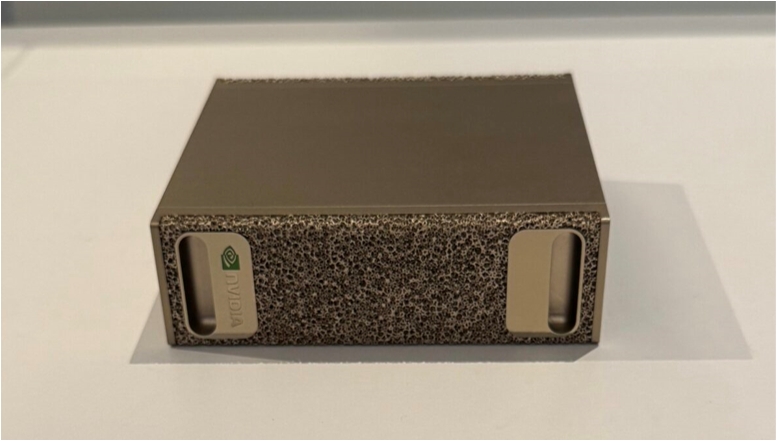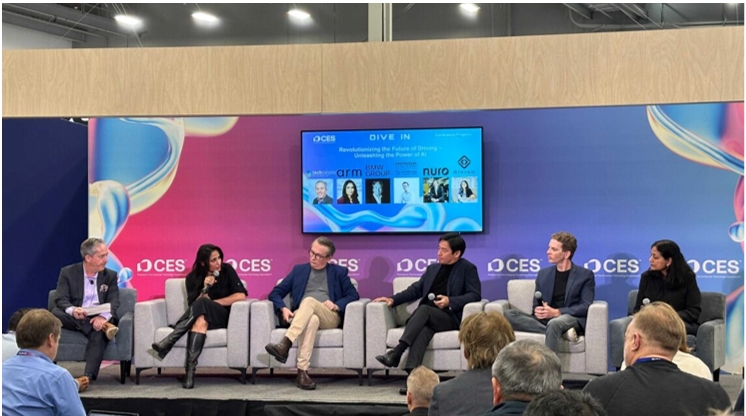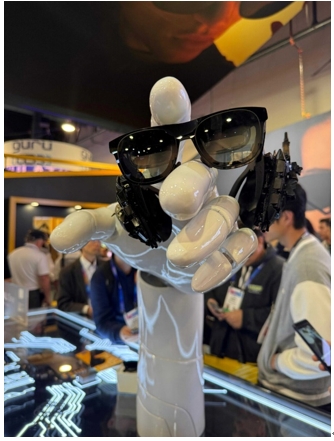Source: Arm Author: Arm
The recent CES 2025 held in Las Vegas, the United States, once again highlighted its role as an important platform to showcase the latest technological innovations. The many cutting-edge products and new launches presented at this year's show will drive change and development in various industries.
Whether it's significant advances in autonomous driving, cutting-edge technology in the consumer electronics technology market, or new partnerships, Arm's appearance at CES 2025 highlights its strong commitment to driving technological innovation in the era of artificial intelligence (AI).
Arm has entered into a landmark partnership with Aston Martin Saudi Aramco F1 Team
Arm announces partnership with Aston Martin Saudi Aramco Formula 1 at CES 2025? Team establishes landmark multi-year partnership with Arm as Team's "Official AI Computing Platform Partner." Arm's computing platform will drive the development of AI and computing in Formula 1, helping Aston Martin Saudi Aramco Racing push the limits of performance on and off the track.
Through this unique partnership, Arm and Aston Martin Saudi Aramco Racing are committed to accelerating the advancement of science, technology, engineering and mathematics education (STEM) and equity and inclusion in the future of motorsport. At the same time, Jessica Hawkins, head of the Aston Martin Saudi Aramco F1 Academy program, has been appointed as an official ambassador for the Arm to work together to inspire opportunities for women in STEM and motorsports. They will also support young engineers, race drivers and innovators.
At this year's show, Ami Badani, Arm's Chief Marketing Officer, and Dipti Vachani, Arm's Senior Vice President and General Manager of Automotive, joined Jessica Hawkins and Charlie Blackwall, head of electronics for the Aston Martin Saudi Aramco F1 team, They discussed the new partnership and how they will work to drive technological innovation and improve equity and inclusion in technology and motorsport.
Pioneering innovation with NVIDIA
Jen-hsun Huang, founder and CEO of NVIDIA, demonstrated NVIDIA's latest AI technology innovations in his keynote speech before the show. Arm technology plays a key role in NVIDIA's next-generation consumer electronics and commercial vehicle solutions. The Arm CPU core is a key component of NVIDIA's new personal AI supercomputer, bringing high-performance AI computing to developers with easy access.
New AI capabilities for the next generation of cars
At the NVIDIA keynote, Huang announced the centralized computing system NVIDIA DRIVE AGX Thor? Advanced AI capabilities are available for a wide range of automotive applications and are expected to be available in production models later this year. It is the first solution to feature Arm Neoverse V3AE, Arm's first Neoverse CPU enhanced for automotive applications. Many leading automakers are already planning to use NVIDIA DRIVE AGX Thor for a new generation of software-defined vehicles (SDVS), including Jaguar Land Rover, Mercedes-Benz and Volvo Cars.
In addition, Toyota, Lotus sports cars, Lucid,? Car companies such as Polar Star, Rivian, Polar Krypton and Zoox have also become partners in the ARM-based NVIDIA DRIVE Orin.
Desktop high-performance AI for developers
NVIDIA is also introducing Project DIGITS, a new personal AI supercomputer that puts desktop, high-performance AI systems within the reach of every AI developer. This will help achieve the popularization of high-performance AI computing, which in turn will set off a new wave of innovation and research.

The Arm platform is the cornerstone of the car of the future
As the large screen at the entrance to the West Hall of the Las Vegas Convention Center shows: "The Arm platform is the cornerstone of the car of the future," 94 percent of the world's automakers use technology based on Arm architecture in their latest models.
At CES 2025, several new models using ARM-based architecture technology were well demonstrated, including Honda's Honda 0 SUV prototype.
Renesas and Honda jointly announced during the show that Honda's new SUV models will run on ARM-based technology, and the two sides have signed an agreement to jointly develop high-performance system-on-chip (SoC) for the new generation of SDVS. The chip will feature Renesas Electronics' new fifth-generation R-Car SoC, which uses an Arm Cortex-A720AE CPU as an application processor and an Arm Cortex-R52 dual-lock step CPU core for real-time processing.
Experts from Honda, BMW, Nuro and Rivian participated in the panel discussion "Revolutionizing the Driving Experience of the Future by unleashing the Power of AI." During the session, Dipti Vachani explained how AI is revolutionizing the automotive industry in three key trends: electrification, autonomous driving, and driver experience.
From representatives from these leading automotive industries, it was clear to Arm that a scalable, consistent, and energy-efficient computing platform is essential to enable the next generation of AI-enabled SDVS.

At the same time, Arm technology is accelerating software for leading automotive applications showcased at CES 2025. Mapbox, a leading platform for location-based services experiences, demonstrated its new Virtual platform, Virtual Head Unit (VHU), developed in partnership with Arm and Corellium.
This is a virtual prototype of on-board hardware built on Arm architecture that can be used before seamlessly integrating with Mapbox's navigation stack. With the new VHU, Oems can build maps on demand and test and render them faster before service deployment.
In addition, Amazon Cloud Technologies (AWS) in the automotive sector demonstrated how Arm optimization supports its development of a chatbot prototype application for a new generation of SDVS.
Innovative consumer technology solutions
Like previous CES, this tech event in Las Vegas showcases a slew of the latest consumer technology innovations. In the exhibition hall, the latest AI TV, smart display and many other new products are dizzying, many of which are using Arm technology.
One bright spot in the TV market is Eclipsa Audio. This open source technology, created by Google, Samsung, Arm and the Open Media Alliance, provides a three-dimensional listening experience that revolutionizes the way audio is heard. By adopting an Immersive Audio Model and Formats (IAMF), Eclipsa Audio transmits audio in both vertical and horizontal dimensions, highly simulating natural environments to create immersive soundscapes.
Arm has played a key role in the technology space by optimizing the Opus codec and the IAMF library to achieve performance gains on Arm cpus. These technical enhancements ensure Eclipsa Audio delivers superior performance across a wide range of consumer electronics products, from high-end theater systems to entry-level mobile devices and TVS.
In addition, two new ARM-based XR products at the show attracted a lot of attention. ThinkAR showed off its AiLens product line, a lightweight AR smart glasses that deliver an intuitive user experience with powerful edge-side AI capabilities. The device is powered by Ambiq's ultra-efficient Apollo4 SoC based on Arm technology.
Together with SoftBank Group, AiLens' presentation covers a wide range of applications and use cases, including healthcare, workplace productivity and training, retail, navigation and travel, education and skills development, and entertainment.
In addition, XREAL showed off its latest XREAL One series of AR smart glasses. These AR wearables are built on Arm Cortex-A CPU technology, and despite their lightweight form, they have excellent display capabilities. Users can generate 3D objects by talking to the device.

As the industry leader, Asus showed off the Chromebook CZ12, which is designed based on the concept of a "rugged, student-centered learning companion." Powered by an ARM-based MediaTek 520 processor, the Chromebook CZ12 is designed to provide students with a rich educational experience through its easy-to-use and rugged design.
Introduce advanced AI capabilities for edge side and endpoint devices
Alif Semiconductor announced the integration of the Arm Ethos-U85 NPU into its second-generation Ensemble microcontroller (MCU) at CES 2025. The new Ensemble MCU and fusion processor are designed to support generative AI workloads, enabling advanced AI capabilities on the edge side and endpoint devices. This is particularly valuable for edge-side AI applications that focus on the fusion of vision, voice, text, and sensors to provide an instant, accurate, and satisfying user experience without relying on the cloud.
Arm's standardized Ethos NPU IP is favored for its superior performance and efficiency, as well as extensive ecosystem support.
Sustainable AI development for the future
On the last day of the show, Ami Badani led an in-depth panel discussion with experts from Meta and NVIDIA on "The Keys to Enabling Sustainable AI innovation." Panelists agreed that the next frontier in AI computing will require unprecedented computing power. Arm, Meta and NVIDIA are committed to delivering energy efficient AI technology and software from cloud to edge. In addition, the discussion also touched on how future AI will provide diverse models for different performance levels and use cases, and how AI resources can be delivered more efficiently to achieve a sustainable AI future.
Arm technology is ubiquitous at CES 2025
Arm technology covers 100% of the world's connected population. At CES, Arm's global partner ecosystem showcased AI innovations across a wide range of sectors. In addition to the impressive launch, Arm's appearance at CES 2025 also laid a solid foundation for the year ahead, continuing to demonstrate that the Arm computing platform is at the heart of all kinds of AI experiences.
免责声明: 本文章转自其它平台,并不代表本站观点及立场。若有侵权或异议,请联系我们删除。谢谢! Disclaimer: This article is reproduced from other platforms and does not represent the views or positions of this website. If there is any infringement or objection, please contact us to delete it. thank you! |
- Prev:Good news! Kunshan Sitwei Integrated Circuit Co., Ltd. was awarded as Jiangsu Province specialized special new small and medium enterprises
- Next:Melexis introduces advanced performance temperature sensors to realize intelligent temperature control of induction stoves with infrared technology innovation


